Gestural input is to some extent inherent in the language of magic, as seen in the phrases to "cast a spell" and to "weave an enchantment." The fantasy of weaving magic can be vividly seen on the cover of LucasArt's Loom (1990), in which two hands weave a glowing cat's cradle out of multi-colored light. (While Loom lacked any kind of gestural interface, its unique mode of musical spellcasting and melodic feedback will figure heavily into a later blog entry on multimodal feedback and audio magic.) Gesture is also an integral part of occultist approaches to magic, ranging from the pentagrams and hexagrams traced in the rituals of the Golden Dawn and Thelemic magick, the sigils drawn by Austin Osman Spare and Buddhist kuji-in mudras later adapted in the ninja-themed anime series Naruto.

Closely related to the idea of gestural magic is the verbal component of spell-casting, which appears in colloquial speech as a magic word. From David Copperfield to Harry Potter and the 2010 Sorcerer's Apprentice remake, the image of a wizard waving a wand and intoning a word in order to release a powerful magic spell pervades public consciousness of enchantment. Magic words are a direct extension of the arcane grammars that govern ritual and the combinatorial systems of runic languages discussed in the first installment of this blog series. Voice recognition software, now a standard part of Windows and readily available in more precise programs such as Dragon NaturallySpeaking, could heighten the immersive possibilities of incantation as a spellcasting method.
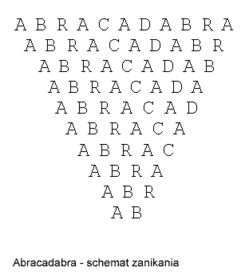 Gestural input, in which players use a variety of input devices to trace symbols or fashion other secret signs with hands and body, is also especially relevant from a technological perspective after the 2010 E3 unveiling of Microsoft's Kinect (formerly project Natal) and the Playstation Move. These devices offer new levels of motion sensing technology, in addition to existing alternative input methods in the Wiimote and Wiimotion Plus, the Playstation Eye, and the force-feedback controls offered by the Novint Falcon. Each technology could be leveraged for new methods of casting spells, provided that designers can break out of the prevailing tray-of-icons approach to magic represented in many popular RPG's.
Gestural input, in which players use a variety of input devices to trace symbols or fashion other secret signs with hands and body, is also especially relevant from a technological perspective after the 2010 E3 unveiling of Microsoft's Kinect (formerly project Natal) and the Playstation Move. These devices offer new levels of motion sensing technology, in addition to existing alternative input methods in the Wiimote and Wiimotion Plus, the Playstation Eye, and the force-feedback controls offered by the Novint Falcon. Each technology could be leveraged for new methods of casting spells, provided that designers can break out of the prevailing tray-of-icons approach to magic represented in many popular RPG's.
Envisioning the most creative use of new gestural and verbal technologies requires, paradoxically, an enterprise of game archeology, looking back into the history of games with magic in a search for hidden gems of unusual interfaces and input methods. Retro gaming and scholarship of retro games can offer a perspective on magic systems before they hardened into a single mold and became homogenized by marketing and ease of use or implementation.
Magic systems in modern gaming begin with early tabletop role-playing. Gary Gygax, in the "The Dungeons and Dragons Magic System," explains that there are four components to spells in his system: somatic, verbal, material, and psychological (which he reduces to mnemonic). In this article and another entitled "Jack Vance and the D&D Game," Gygax also refers to this system as "Vancian" because of Jack Vance's "Dying Earth" fantasy book series, in which magicians memorize a limited number of spells and trigger them through a gesture and word, after which the spells are promptly forgotten and must be re-memorized. The verbal component takes predominance in D & D because tabletop role-playing games are played verbally, through conversational exchange between players and DM. Other elements seem to be thought of by Gygax as present for the purpose of game balance, as when he implies that the gestural system ensures that a magician couldn't cast a spell if he were wrapped in webs or that a magic mouth couldn't be used to cast spells by proxy.
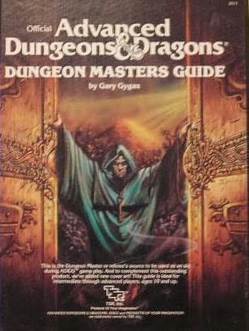 The verbal component of magic is a powerful fantasy and a metaphor for the way that language can shape the human understanding of reality. When a stage magician speaks "abracadabra" and waves a wand in order to conjure a rabbit from a hat, the magician is tapping into a primal fantasy of ultimate power: we have only to speak, and our words will have an immediate physical effect. This belief in the mystical power of language is also the impulse behind the elaborate meditations on letter and word that constitute the esoteric system of the kabbalah.
The verbal component of magic is a powerful fantasy and a metaphor for the way that language can shape the human understanding of reality. When a stage magician speaks "abracadabra" and waves a wand in order to conjure a rabbit from a hat, the magician is tapping into a primal fantasy of ultimate power: we have only to speak, and our words will have an immediate physical effect. This belief in the mystical power of language is also the impulse behind the elaborate meditations on letter and word that constitute the esoteric system of the kabbalah.
The problem with the verbal component of magic as enacted within tabletop role-playing is that this component is not performative, or rather it is performative only one step removed from gameplay. The player says "I am casting a spell," and it is understood that the player-character is reciting a complex incantation that was memorized from a spellbook. However, the player never utters the incantation (or makes the gesture or handles the ingredients). He only declares that he is going to do so: a speech act that is accepted or rejected by the Dungeon Master and other players if it conforms to the game's rules. (A later tabletop role-playing game, Ars Magica (1987), actually does require players to master a Latinate grammar in order to cast spells, though this magical grammar appears in tabletop games only after similar systems appear in computer RPG's like Dungeon Master).
Missing from tabletop RPG's is the element of simulation provided by computers, the feeling of performing magic within a multimedia environment designed to reinforce that fantasy rather than merely announcing that one is casting a spell and relying on the shared imagination of one's comrades. Early attempts at simulating magic in computer games relied heavily on a verbal component, but of a different kind derived from player interaction with a text parser.
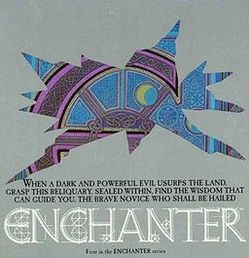 By introducing the text parser with its underlying grammar, game designers begin to address another problem with the Vancian system, in which magic is rote: a litany, a pre-memorized recitation or a single word. If magicians study for years, and if their magic is an arcane art known only by a few, then where is the skill or art of memorizing a pre-defined speech? Those who have mastered an art or a science understand its underlying principles well enough to be able to apply them spontaneously. Fluency in a language entails a mastery of its vocabulary and underlying grammar such that the speaker can produce new utterances rather than merely copying those heard before. Indeed, the generative nature of grammar allows speakers to express ideas never envisioned by those who originally developed and codified the language. If magic is a grammar, then mastery of that grammar is displayed through the ability to adapt its structures to novel situations. The text parsers of interactive fiction were in some ways well adapted toward inviting such grammatical interactions; indeed, an interactive fiction is in part an object-oriented simulation explorable through exchanges governed by the rules of grammar. The text parser of Colossal Cave Adventure accepts the famed magic word XYZZY, thereby allowing players to experience the verbal component of magic as a simulation, albeit a simple one.
By introducing the text parser with its underlying grammar, game designers begin to address another problem with the Vancian system, in which magic is rote: a litany, a pre-memorized recitation or a single word. If magicians study for years, and if their magic is an arcane art known only by a few, then where is the skill or art of memorizing a pre-defined speech? Those who have mastered an art or a science understand its underlying principles well enough to be able to apply them spontaneously. Fluency in a language entails a mastery of its vocabulary and underlying grammar such that the speaker can produce new utterances rather than merely copying those heard before. Indeed, the generative nature of grammar allows speakers to express ideas never envisioned by those who originally developed and codified the language. If magic is a grammar, then mastery of that grammar is displayed through the ability to adapt its structures to novel situations. The text parsers of interactive fiction were in some ways well adapted toward inviting such grammatical interactions; indeed, an interactive fiction is in part an object-oriented simulation explorable through exchanges governed by the rules of grammar. The text parser of Colossal Cave Adventure accepts the famed magic word XYZZY, thereby allowing players to experience the verbal component of magic as a simulation, albeit a simple one.
Infocom's Spellbreaker trilogy, consisting of Enchanter, Sorcerer, and Spellbreaker, entails a magical grammar, in which spells are verbs that take direct objects, allowing players to type "frotz stone" to make a stone glow or "blorb chest" to open this locked container. Frotz and Blorb are names for, respectively, an interactive fiction interpreter and a wrapper for multimedia elements. While amusing, this application of the names of in-game spells to the programming and technology outside of and supporting the game also suggests a powerful relationship between programming and the verbal grammars of magic. Simply put, programmers and magicians both master a grammar in order to make things happen. Both hackers and wizards achieve this alteration of reality, whether simulated or real, through an arcane set of words and phrases known as programs or spells. When properly configured, a program causes amazing events to occur (calculates our taxes, launches an anti-missile defense system, summons a longed-for package from Amazon.com to our doorstep), just as magicians can throw fireballs and (when very powerful) grant wishes. However, when the programmer makes the slightest error in the placement of a semicolon or case sensitivity, the program won't compile, much as a spell fizzles.
In the case of the Spellbreaker trilogy, the games' designers consciously drew upon these parallels between magic and programming As Wikipedia explains "There are references scattered throughout Enchanter's documentation and gameplay comparing the use of spells by mages to the use of command line interfaces by programmers, and comparing mages to hackers in general. Many of the spell names, such as FROTZ and GNUSTO, are taken from MIT hacker slang of the time" (Wikipedia "Enchanter" ). There is a strong element of meta-magic and self-referentiality in this spell system, since the magic used to attain supernatural result within the game is patterned on the very methods used to create the game itself. Other text-based magic systems include the early Ultima games, such as Ultima IV , in which players type the names of spells into text parsers. Players also control a text-based inventory of spell elements, called reagents, which they mix in the correction proportion in order to alchemically prepare a spell.
Though these text-based magic systems are fascinating, they leave out a sense of visual interaction and movement. When we imagine a magician casting a spell, we see him waving his hands in complex patterns while bolts of electricity arc from his hands. It is here that the intersection of grammar and gesture occurs. While Black and White (2001) may be the first gestural interface used for magic, the designers of The Summoning (1993) attempted to simulate gestural spellcasting through a set of hand gestures that could be combined to store spells. These hand gestures resemble the finger alphabet of American Sign Language, as well as the magical gestures made by Aleister Crowley or the kuji-in.
 This form of spell-casting involves an implicit pun on the two meanings of "spell" as in "incantation with magical force" and "to form a word out of letters." If a grimoire is etymologically and conceptually linked to a magical grammar, then it makes sense that spells themselves consist of an alphabet, rendered gesturally to emphasize its performativity and multi-modality. Players of The Summoning arrange graphical representations of hand gestures onto a tray, much as players of Ultima Underworld concatenate runes. Indeed, The Summoning combines a system of hand gestures with a set of collectable rune stones, partially in acknowledgement that the possibility of actual physical hand-gestures on the part of the user was technologically out of reach in 1993 (in part due to the imprecision of alternative controllers like Nintendo's 1989 Powerglove).
This form of spell-casting involves an implicit pun on the two meanings of "spell" as in "incantation with magical force" and "to form a word out of letters." If a grimoire is etymologically and conceptually linked to a magical grammar, then it makes sense that spells themselves consist of an alphabet, rendered gesturally to emphasize its performativity and multi-modality. Players of The Summoning arrange graphical representations of hand gestures onto a tray, much as players of Ultima Underworld concatenate runes. Indeed, The Summoning combines a system of hand gestures with a set of collectable rune stones, partially in acknowledgement that the possibility of actual physical hand-gestures on the part of the user was technologically out of reach in 1993 (in part due to the imprecision of alternative controllers like Nintendo's 1989 Powerglove).
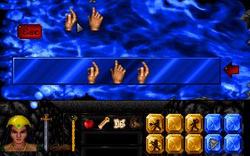
 The first true gestural interfaces for spell-casting are mouse-driven and operate around the metaphors of painting and drawing. Such elements are common to occultist practice, as in the rituals of the pentagram and hexagram in the Golden Dawn and Thelemic magic. In these rituals, magicians use ritual implements like wands and daggers to trace five and six-pointed stars whose points have elemental or planetary correspondences. The starting and ending points of the geometrical figures determine whether the sign banishes or invokes, as well as what elements are specifically called up or driven away.
The first true gestural interfaces for spell-casting are mouse-driven and operate around the metaphors of painting and drawing. Such elements are common to occultist practice, as in the rituals of the pentagram and hexagram in the Golden Dawn and Thelemic magic. In these rituals, magicians use ritual implements like wands and daggers to trace five and six-pointed stars whose points have elemental or planetary correspondences. The starting and ending points of the geometrical figures determine whether the sign banishes or invokes, as well as what elements are specifically called up or driven away.
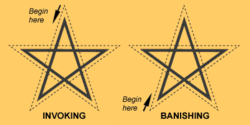 Similarly, players trace such geometric forms, including pentagrams, using the hand that constitutes the HUD-less interface of Black and White (2001), in order to perform miracles. Black and White featured a patch allowing use of the P5 Virtual Reality glove, which can be used to control the computer's mouse as well many games through GlovePie, freeware created by Carl Kenner. The use of a hand to control a hand-shaped cursor in a game without a HUD added to the sense of immersion in spell-casting by removing any barrier between player and game.
Similarly, players trace such geometric forms, including pentagrams, using the hand that constitutes the HUD-less interface of Black and White (2001), in order to perform miracles. Black and White featured a patch allowing use of the P5 Virtual Reality glove, which can be used to control the computer's mouse as well many games through GlovePie, freeware created by Carl Kenner. The use of a hand to control a hand-shaped cursor in a game without a HUD added to the sense of immersion in spell-casting by removing any barrier between player and game.
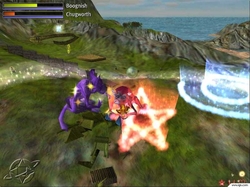 Drawing as a spellcasting mechanic can also potentially be used in any game with sigils, although this element is often removed from gameplay and used as mere decoration. Sigils, illustrated in grimoires such as The Lesser Key of Solomon the King, are elaborate signs or seals, often inscribed with cryptic geometric designs and the names of angels and demons. Grimoires teach aspiring magicians to draw sigils on the ground in order to ward off or contain spirits. Conjurers could also inscribe sigils on amulets in order to create talismans consecrated to spirits and elemental forces.
Drawing as a spellcasting mechanic can also potentially be used in any game with sigils, although this element is often removed from gameplay and used as mere decoration. Sigils, illustrated in grimoires such as The Lesser Key of Solomon the King, are elaborate signs or seals, often inscribed with cryptic geometric designs and the names of angels and demons. Grimoires teach aspiring magicians to draw sigils on the ground in order to ward off or contain spirits. Conjurers could also inscribe sigils on amulets in order to create talismans consecrated to spirits and elemental forces.
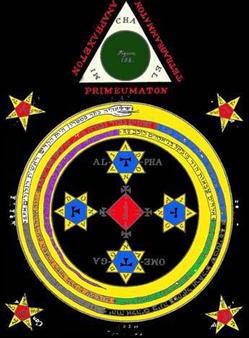 Sigils and the grimoires containing them have played a role in the story and art design of many magic systems, including Vagrant Story (2000) and World of Warcraft: Wrath of the Lich King. Common artistic practice involves arcane symbols that glow and spin beneath the caster during spell-casting, as seen in Neverwinter Nights and World of Warcraft. Voices chanting ominous symbols often appear during this casting phase, but players are rarely able to interact with them. Chanting and sigil-drawing are cosmetic features designed to reinforce an enchantment mood but divorced from player interaction; in all too many RPG's, voice and drawing are neither input methods affecting the spell that is cast nor feedback mechanisms to reinforce how it is cast. The removal of sigils from input or feedback squanders their potential as gameplay mechanicisms and runs directly contrary to their role in magical lore, in which magicians learn to draw sigils for direct practical ends.
Sigils and the grimoires containing them have played a role in the story and art design of many magic systems, including Vagrant Story (2000) and World of Warcraft: Wrath of the Lich King. Common artistic practice involves arcane symbols that glow and spin beneath the caster during spell-casting, as seen in Neverwinter Nights and World of Warcraft. Voices chanting ominous symbols often appear during this casting phase, but players are rarely able to interact with them. Chanting and sigil-drawing are cosmetic features designed to reinforce an enchantment mood but divorced from player interaction; in all too many RPG's, voice and drawing are neither input methods affecting the spell that is cast nor feedback mechanisms to reinforce how it is cast. The removal of sigils from input or feedback squanders their potential as gameplay mechanicisms and runs directly contrary to their role in magical lore, in which magicians learn to draw sigils for direct practical ends.
For example, the process of "sigilization" formulated by visual artist and magician Austin Osman Spare entailed an "alphabet of desire" designed to encode and give magical force to the magician's deepest longings. Spare's dual identity as a painter and a magician highlights a potential relationship between magic and the visual arts that could be capitalized on with any PC or console that has drawing capabilities, including tablet PC's, the Nintendo DS or 3DS, and the Wii. For example, drawing and painting become a game mechanic and visual trope in the magnificent Okami, in which the player uses a magical calligraphy brush to alter reality within a world that constitutes a living Japanese painting.
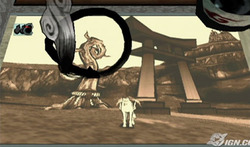 Using one's magic pen to fill in the gaps in a bridge can mend the wood to allow passage, just as painting the barren branches of a tree can cause it to blossom with fruit. Dawn of Sorrow, an iteration of Castlevania for the Nintendo DS, also requires players to inscribe seals using the DS stylus in order to defeat bosses, which otherwise regain strength and resurrect themselves.
Using one's magic pen to fill in the gaps in a bridge can mend the wood to allow passage, just as painting the barren branches of a tree can cause it to blossom with fruit. Dawn of Sorrow, an iteration of Castlevania for the Nintendo DS, also requires players to inscribe seals using the DS stylus in order to defeat bosses, which otherwise regain strength and resurrect themselves.
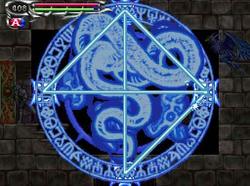
Magic as a hybrid of writing and painting opens many possibilities of multimodal input and feedback with cosmological significance, seen most vividly in the use of symbolic color to represent schools and varieties of magic. These subjects and others will be discussed in the third installment of this blog series next Wednesday.


The Law of Thelema is a system of experiential spirituality.I like to practise.
Two comments, one nitpicky: blorb seals objects in magical containers, so 'blorb chest' would actually put the chest in another magical chest (the opening spell you're thinking of is "rezrov").
Apropos of gestural magic in games --- are you familiar with Richard Bartle's Spellbinder (or Andrew Plotkin's computer implementation Spellcast)? Gestures are key to its magic system, but it doesn't fit into anything resembling a narrative structure: the gestural magic system is more-or-less the entirety of the game, rather than the magical layer on a larger work.
@Mary: Do you think that spam comments are part of the Law of Thelema? (If by chance you're not spamming, I'd sincerely like to hear your thoughts on magic and games.)
@Jake: Thank you for the Blorb correction. I'll edit the piece accordingly. I hadn't heard of Richard Bartle's Spellbinder or Andrew Plotkin's Spellcast (though I am a fan of The Dreamhold and Zarf's work generally). I'll check both of them out.
(That first comment is certainly spam. I've deleted the URL but left the comment, since it's infinitesimally on-topic.)
Bartle's game is basically a strategy game played with gestures -- or symbols of gestures. The original rules say that players will write their turns down on paper (to be revealed simultaneously). You *could* play with actual hand gestures, but both players would need very good memories.
(My description of it, along with some very old Unix source code, is at http://www.eblong.com/zarf/spellcast.html .)
Implementation of these kinds of systems show up in the strangest places. SSX Blur [a snowboarding game for the WII] required players to first unlock and then memorize increasingly-complex gestural patterns to perform airborne tricks. As they grew in complexity, they also grew in ridiculousness, resembling magic more than any kind of real-world athletic prowess.
"VAS REL POR," and i'm out.
Jeff, you might be interested in the short IF game Suveh Nux. It uses a magic system somewhat like the Spellbreaker games but has some nice little complications to it.
@Andrew: Thanks for the link to the Spellcast code and for the information about Bartle's game. Your version looks great, though I've never compiled Unix code before.
@Kris: That's funny about SSX Tricky's gestural interface. I wonder if many sports games and music games might be said to contain something approaching a magic system, or at least provide useful lessons about constructing immersive interfaces in magic systems. In your example, it seems like the SSX gestures start to resemble magic precisely when they stop having a direct physical relation to snowboarding. This is an interesting paradox.
@Kevin: Suveh Nux looks great, since the reviews suggest it has a highly developed and flexible magical grammar. I'd like to play it soon.
One note about Castlevania: Dawn of Sorrow, though. Most reviews said the "Draw a Seal" mechanic simply did not mesh. Compared to other Castlevania games, where depleting the boss's hit points was good enough. Also, you learned 5 seals throughout the game. Basically, it wasn't enough and it ran counter to Castlevania. It also forced users to pull out their stylus when you can play the rest of the game with the buttons alone. Maybe a stylus-only Castlevania?
I mentioned Lost Magic in the previous post, where you use the stylus to command your monsters and use it to cast magic by drawing runes. For me it got a bit too complex (also, I suck at RTS games.) I felt like I had to be an octopus to play it properly.
@Chad:
Thank you for both your comments. It's great to hear about your fast-paced dungeon-crawling game and its potential drawing mechanic.
As for Castlevania, it may be that for many people the seal drawing was a distraction from the core mechanic of the franchise. That reaction is not surprising, and it is a reminder that many magic systems follow a uniform "tray of icons" approach to magic because it is accessible to gamers familiar with this interface. When designers introduce new mechanics (especially to established franchises), they run the risk of temporarily alienating players annoyed by a new learning curve. That said, designers who take risks have the potential of creating something richer and more immersive.
Thank you also for the Lost Magic recommendation. Of DS games, I am most interested in the stylus mechanic of Knights in the Nightmare, an RTS/RPG/bullet hell shooter hybrid in which players use the stylus to control a phantom who can resurrect dead knights. The extremely positive Ign review of this game noted that it was the most complex game the reviewer had ever played, and that this degree of depth could be either entrancing or frustrating, depending on one's tastes.
My hope is that players who want the immersive experience of casting spells will be willing to tolerate the learning curve involved. If magicians are reputed to spend years honing their art, then maybe we're not being unreasonable to ask players to take a few hours to master a non-standard interface. Perhaps this learning curve might even be said to be part of the immersion: the experience of being a sorcerer's apprentice or a neophyte ascending the ranks of initiation to adept.
"I wonder if many sports games and music games might be said to contain something approaching a magic system..."
Makes sense to me. Text games tend towards verbal magic for a verbal interface; console controllers are an inherently gestural interface, and also inherently abstract (more so than text parsers). The process of using a console controller *is* symbolic manipulation; it only relates to the avatar's physical action through a few vague genre conventions. (Left stick walk, right stick glance... or is it the other way around? But the gameplay winds up being contextual combinations of circles, squares, triangles, and three wavy lines...)
The "noun" part of the grammar -- the analogy to Enchanter's "box" and "door" targets, or the spell components of the RPGs -- appears in the action game as environmental elements: grabbable ledge, breakable wall, swingable rope.
But maybe this is just generalizing "magic" to cover *any* gameplay mechanic. Do you want to limit the discussion to mechanics that are represented as magic *in the story*?
(The most recent Prince of Persia game puts you through several levels of jumping, climbing, and swinging before you gain the magical ability to freeze water and thus climb on *that*. It doesn't wind up feeling like the addition of magic; it's just a new acrobatic ability.)
“The process of using a console controller *is* symbolic manipulation; it only relates to the avatar's physical action through a few vague genre conventions. (Left stick walk, right stick glance... or is it the other way around? But the gameplay winds up being contextual combinations of circles, squares, triangles, and three wavy lines...)”
Yes! I’ve been trying to articulate that thought for a while and haven’t quite been able to say it with the clarity that you did. Many action games, like God of War or Dante’s Inferno, feature a subset of moves labeled as “magic,” which are often triggered by a simple combo (e.g. left trigger 1 and X) and powered by a mana meter. To me, though, these moves don’t feel like magic. Rather, the main system of combos designed to simulate combat can feel like magic because of the abstract symbolic manipulation fused with rhythm and timing. In Bayonetta, the entire combo-based combat system becomes a metaphor for magic in which combos are spells. Because Bayonetta’s combat is so graceful and subtle, this metaphor rings true; mastering combat on “normal” mode (which is actually hard mode, at least by my standards) requires the patience of an amnesiac witch slowly re-initiating herself in her dark arts.
To quote from another point in your comment:
“But maybe this is just generalizing "magic" to cover *any* gameplay mechanic. Do you want to limit the discussion to mechanics that are represented as magic *in the story*?
(The most recent Prince of Persia game puts you through several levels of jumping, climbing, and swinging before you gain the magical ability to freeze water and thus climb on *that*. It doesn't wind up feeling like the addition of magic; it's just a new acrobatic ability.)”
It does seem illogical to extend magic systems to include any game mechanic, but it also seems too restrictive to argue that only mechanics explicitly labeled as magic within the game’s narrative can fall within the category of magic system. I’ve boldfaced the sentence in your quotation that seems most important to me. The key criterion for defining a mechanic as part of a magic system (and for evaluating its success) is the extent to which it feels like magic. To use the Prince of Persia franchise as an example, the previous Prince of Persia reboot featured a female companion named Elika who in the narrative was represented as having magical powers, which manifested through magical Persian calligraphy that emanated from her body and assisted the Prince through chain attacks, rescue, and purification of the game’s areas. Beautiful though this calligraphy style of magic was, it never felt like magic to me because I had almost nothing to do with it in terms of interactions. On the other hand, the four powers that I gained (including flying, running up walls, leaping between magic circles, and swinging from a disembodied hand) did feel like magic because of a mixture of gameplay, visual, and auditory cues. In gameplay, these powers are sufficiently outside of the physics system that ordinarily governs its combat and acrobatics that they feel supernatural. While the Prince’s “ordinary” powers are already superhuman by realistic standards, the magical powers more flagrantly violate rules of gravity and velocity in a way that communicates an experience of transcending the moment-to-moment grind of hack-and-slash combat and platforming. Visually, the magical powers are triggered by symbolically colored glowing circles first found within parallel dimensions consecrated to the benevolent deity of Zoroastrianism, and the game consistently uses glowing shaders to communicate a mood of enchantment. Auditorily, Zoroastrian incantations enshroud these powers in a magical mood.
Alas, console action games rarely map their systems of symbolic manipulation to a semantic or evocative system of magic, even when they come tantalizingly close. The esoteric angelic language of Enochian pervades Bayonetta as visual feedback during torture attacks, cryptic inscriptions on objects, and incantations spoken during Wicked Weave moves. But mastery of Bayonetta’s combat-based spells never involves manipulation of the angelic alphabet, any more than picking up the kuji-in in Ninja Gaiden entails any experience of these symbolic hand gestures as an integral combat mechanic with Buddhist (as they are in the lore of Naruto). The closest Bayonetta comes to this sort of symbolic mapping involves the gradual appearance of Enochian letters while powering up torture attacks. To invest the abstract manipulations of a combo system with metaphysical force tied closely to gameplay would create a highly cerebral action game that would likely alienate its core demographic. Yet, console action games do have powerful lessons to teach about gestural immersion and strings of symbolic manipulation that could be applied effectively within a related genre in order to create richer magic systems.
Street Fighter comes to mind as well, with advanced "master" players being the ones who have muscle-memorized the gestures for throwing fireballs and supernatural Dragon punches. The Force Unleashed expands on this significantly, especially on the Wii, where the gestures seemed a natural part of the action of using The Force. And even though I know you're not fond of Harry Potter's simplification of spellcasting, the Wii games did feature a similar gestural system, and the game actually encouraged players to speak the incantations aloud to aid in the performance (though the game did not measure this in any way).
What I would like to see is the inclusion of some EEG style controllers (which are being made now) that measure the player's "focus" and requires them to perform significant mental work to implement magic. combine that with gestural and audio mechanics and you'd really be blurring the lines :)